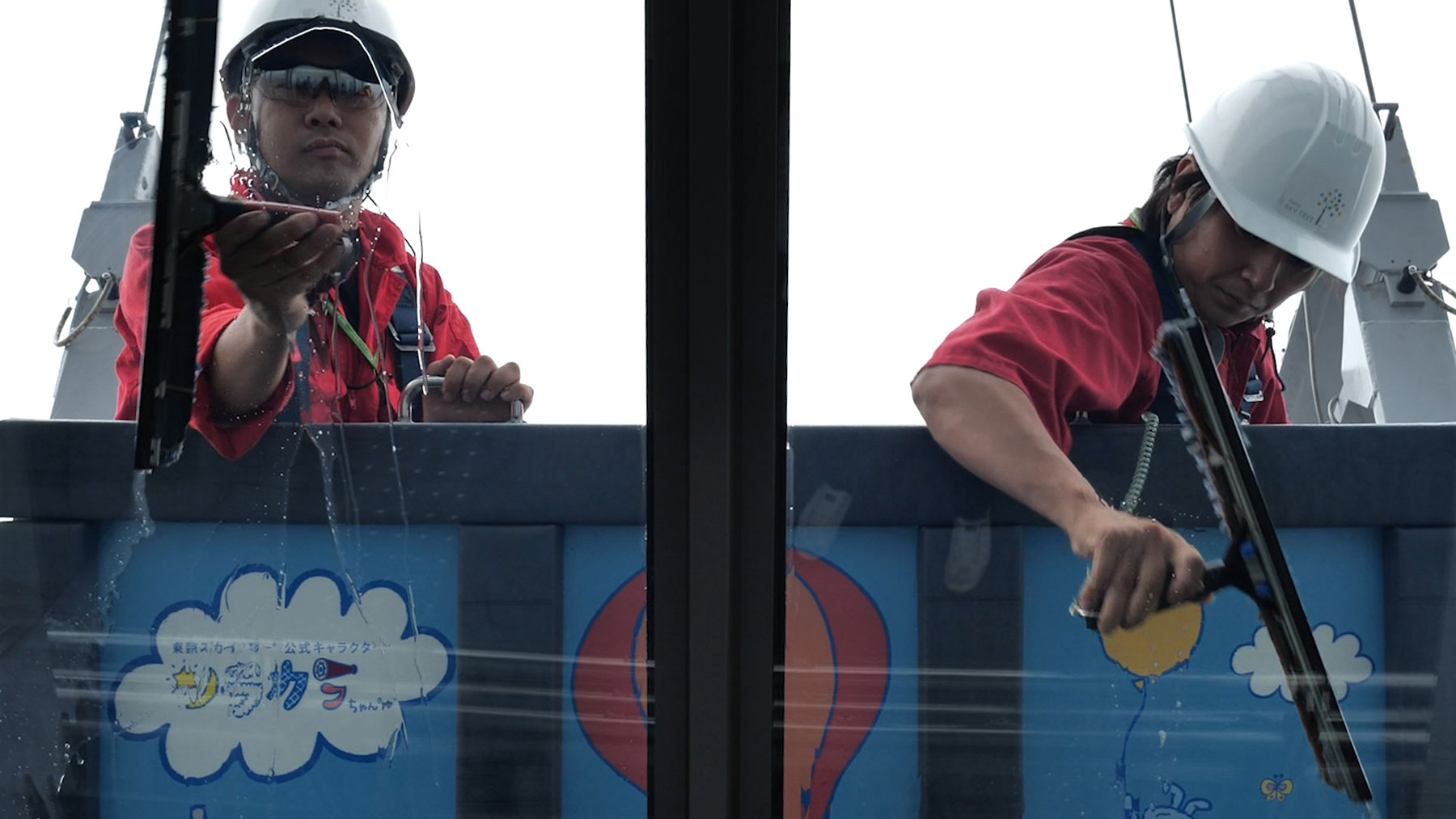LIFE
Friends in high places
Tokyo Skytree’s window washersVertigo-inducing job not for everyone, but the views are nice
ANDREW McKIRDY
Staff writer
How would you like to spend an afternoon dangling 450 meters above the ground in a metal basket with room for only two people?
For Takuma Tachibana, it’s just another day at the office.
“I’ve always liked high places,” says the 32-year-old, as he prepares for another shift cleaning the windows of the world’s tallest tower, Tokyo Skytree. “I’ve never thought of it as being anything scary.”
Skytree, located in Sumida Ward and completed in 2012, stands at a height of 634 meters, making it the second-tallest structure in the world after the 829.8-meter Burj Khalifa skyscraper in Dubai, United Arab Emirates.
The tower has two observation areas for visitors — Tembo Deck at 350 meters and Tembo Galleria at 450 meters. For visitors to be able to properly enjoy the view from either deck, however, the windows must be kept clean.
That’s where Tachibana and his fearless colleagues come in.
Hanging out: Tokyo Skytree window washers must be secured by ropes and clips, nothing is allowed to be carried in pockets and all cleaning tools must be attached to a lanyard so that nothing can fall to the ground. CHISATO TANAKA
The workers, who Skytree contracts from building services company Niwatech, clean the tower and the surrounding buildings six or seven times a month and usually work from 6:30 a.m. to 4 p.m. First, they clean the windows of the office buildings and shops that make up the wider Tokyo Skytree Town before the 10 a.m. opening time. Then, in the afternoon, they move on to Tembo Galleria on the tower itself.
The gondola that they use to reach the windows is stored in a hangar above the 450-meter-high observation deck. The gondola is 170 centimeters tall by 105 centimeters wide and 60 centimeters across, and moves on a rail around the roof’s curve, from where it is lowered.
For obvious reasons, safety is of paramount importance. Workers must be secured by ropes and clips, nothing is allowed to be carried in their pockets and all cleaning tools must be attached to a lanyard so that nothing can fall to the ground. Operations will also be canceled if rain, thunder or winds exceeding 7 mph (11 kph) are forecast.
Complications in the window-cleaning business are rare, but not unheard of. Before working on Skytree, Tachibana cleaned skyscrapers in the capital’s Shinjuku district. On one occasion, the gondola he was using stopped working and he was left stranded around 100 meters above the ground before someone from the firm could come and fix it.
“I was stuck for about three hours, right in the dead of winter,” he says. “I remember really needing to go to the bathroom, and it was cold. I had something to drink, but I knew that if I drank it, I would need to go to the bathroom even more. I didn’t really know what to do.”
Tachibana has encountered no such difficulties working on Skytree, and he is not fazed by the vertigo-inducing view as he goes about his work. In fact, as he surveys the vista of the city, taking in the new National Stadium, Tokyo Tower, the Imperial Palace, the Tokyo Government Buildings and Odaiba’s Rainbow Bridge, among other landmarks, he counts himself lucky to be up there.
“You don’t often get the chance to look at scenery from this kind of height,” Tachibana says. “Being able to take in this view and feel the breeze without any windows in front of you is one of the privileges of the job. When there’s no glass, you see the full panorama and get a sense of realism.”
Not everyone shares Tachibana’s enthusiasm for the task.
The reaction from Skytree visitors inside Tembo Galleria when he and his colleague heave into view is one of astonishment, with one man joking: “It’s not a job that humans should be doing.”
There is also widespread excitement and admiration as children race to the window to wave at the cleaners, however, and Tachibana is quick to respond in kind.
“A lot of people wave at us and we wave back,” he says. “Kids either stare at us or wave at us. It’s nice. You don’t really get the chance to wave at people in this line of work. When you’re cleaning other buildings, they’re usually offices and the people working in them aren’t really interested. Here, you get a lot of tourists.
“You can communicate with the visitors,” he says. “Even with people from overseas, I don’t know what they’re saying but you can make eye contact with them or share a laugh. It’s fun.”
Japan is currently experiencing a tourism boom, with government figures showing that a record 16.63 million overseas visitors arrived in the first six months of 2019 — up 4.6 percent from a year earlier. The government has set a target of attracting 40 million visitors annually from this year.
Skytree, with 4.27 million visitors last year, has become a major tourist draw. With Tokyo also set to welcome the world for the Olympics and Paralympics next year, Tachibana is happy he can play a part.
“I’m proud to work here,” he says. “It feels like recently there are a lot of visitors from overseas. Skytree has been open for seven years now and it’s become an established tourist destination. Next year is the Tokyo Olympics, and from now on, Skytree will have more chances to show itself off to the world. I feel like I can help with that.”


